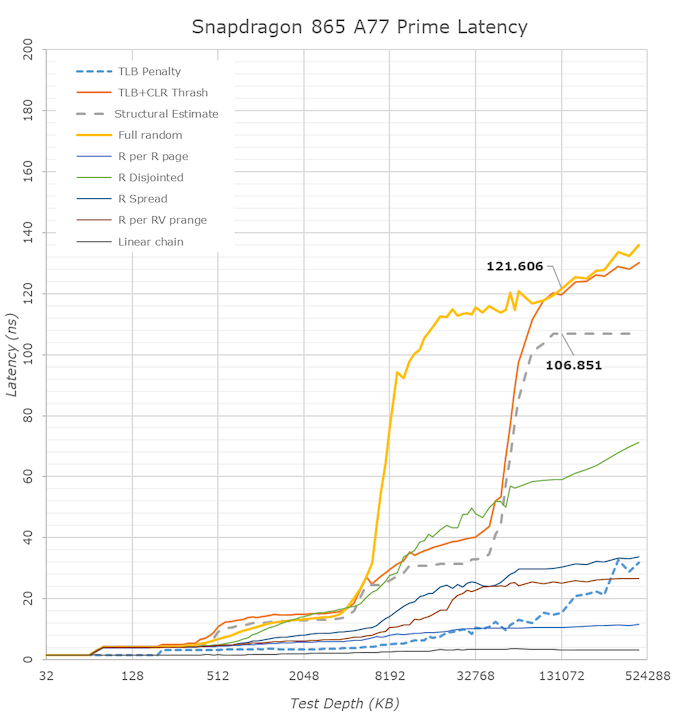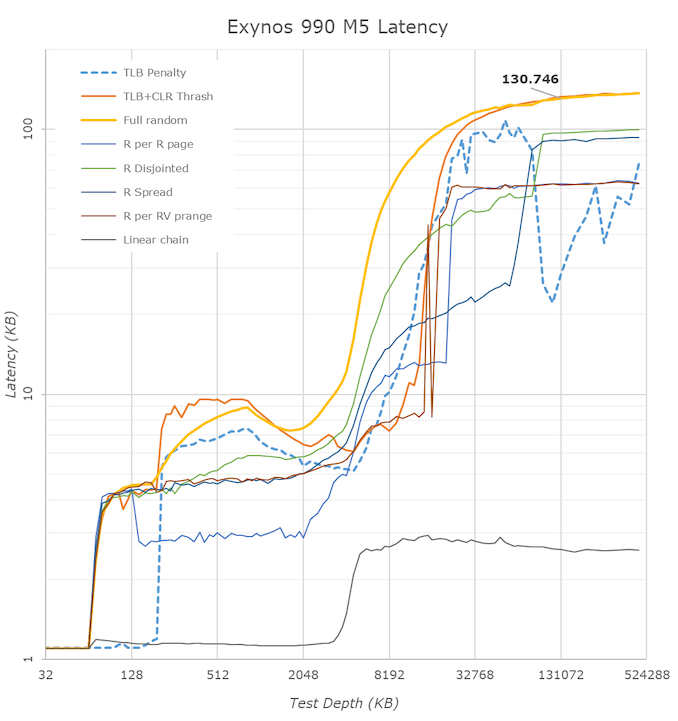The Samsung Galaxy S20+, S20 Ultra Exynos & Snapdragon Review: Megalomania Devices
by Andrei Frumusanu on April 3, 2020 9:30 AM ESTMemory Subsystems Compared
On the memory subsystem side, there’s quite a few big changes for both the Snapdragon 865 as well as the Exynos 990, as these are the first commercial SoCs on the market using LPDDR5. Qualcomm especially is said to have made huge progress in its memory subsystem, and we’re now able to verify the initially promissing results we saw on the QRD865 back in December with a production device.
And indeed, the news keeps on getting better for Qualcomm, as the new Galaxy S20 showcases even better memory results than we had measured on the reference device. The improvements over the Snapdragon 855 are just enormous and Qualcomm not only manages to catch up but very much now is able to beat the Exynos chips in terms of memory subsystem performance.
Arm very famously quotes that an improvement of 5ns in memory latency corresponds to an increase of around 1% in performance. And if that’s the case, Qualcomm will have had a ~12% improvement in CPU performance just by virtue of the new memory controller and SoC memory subsystem design. Our structural estimate in the memory latency falls in around 106 vs 124ns – most of the improvement seems to be due to how Qualcomm is now handling accesses to the DRAM chips themselves, previously attributing the bad latencies on the Snapdragon 855 due to power management mechanisms.
Samsung’s Exynos 990 also improves in memory latency compared to the Exynos 9820, but by a smaller margin than what the Snapdragon 865 was able to achieve. All latency patterns here are still clearly worse than the Qualcomm chip, and there’s some oddities in the results. Let’s zoom in into a logarithmic graph:
Comparing the Exynos 990 results vs the Exynos 9820, it’s now quite visible that the L2 cache has increased dramatically in size, similar to what we’ve described on the previous page, corresponding to the doubling of the available cache to a core from 1MB to 2MB. Samsung’s cores still have some advantages, for example they’re still on a 3-cycle L1 latency design whereas the Arm cores make due with 4-cycle accesses, however in other regards, the design just falls apart.
The TLB issues that we had described last year in the M4 are still very much present in the M5 core, which results in some absurd results such as random accesses over a 2MB region being actually faster than at 1MB. Cache-line accesses with TLB miss penalties now actually have lower access latencies in the L3 than in the L2 regions, and I have no idea what’s happening in the 16-64MB region in that test as it behaves worse than the 9820.
Examining the A76 cores of the Exynos 990, we see a much cleaner set of results more akin to what you’d expect to see from a CPU. Here we also see the 2MB SLC cache hierarchy in the 1-3MB region, meaning the Arm core cluster does have access to this cache, with the M5 cores bypassing it for better latency. Last year I had noted that the A76’s prefetchers had seen some massive improvements, and this is again evident here in the result sets of the two CPUs on the same chip as the middle cores actually handle some access patterns better than the M5 cores.
Samsung has had large issues with its memory subsystem ever since the M3 design, and unfortunately it seems they never addressed them, even with the more recent M5 core.
The Snapdragon 865 here is quite straightforward. The biggest difference to the 855, besides the improved DRAM latency, is the doubling of the L3 from 2 to 4MB which is also immediately visible. It still pales in comparison to the Apple A13’s cache hierarchy, but we do hope that the Arm vendors will be able to catch up in the next few years.













137 Comments
View All Comments
iphonebestgamephone - Sunday, April 5, 2020 - link
Oh and what does a pro like you use?sanjeev.k - Saturday, April 4, 2020 - link
Hi Andrei,Thanks for your detailed review. Any change Anandtech will be reviewing the note 20 later in the year (as Anandtech have not reviewed the note xx series past few years) ?
Reliable leaker @IceUniverse hints that Note series will implement an optimised solution for 120 Hz refresh rate - so I am assuming that to mean that power inefficiency issues at 120 hz refresh rate will be fixed in the note series.
If you are going to review the Note series, at least we will know whats the improvement like as compared to Galaxy S series. Then I can decide if I want to import the Snapdragon 865 Note series or import S20 865 series and bear with the 120 Hz power consumption issue
abufrejoval - Saturday, April 4, 2020 - link
I bought the first Galaxy Note for its size: My hands are much more capable than my eyes up close. I stuck around for the Note 3 and then abandoned the brand as they went off into Absurdistan with too much glass and metal replacing replaceable batteries (both Notes still work today with 2nd and 3rd sets of batteries).But I’ve always longed to see another feature become mainstream usable, that these Notes started, albeit with serious functional limitations: Desktop or docking mode.
The Note 2 dock also worked with the Note 3 and it was the first that I tried to use for extra light business travel with a foldable BT keyboard even a BT mouse on an HDMI connected big screen. Mixed DPI support wasn’t quite up to snuff, even with custom ROMs that added Ethernet connectivity (security constraints mandated that in some cases).
In terms of computing power everything since the 820 has been enough for me in mobile use: If I really want to crunch numbers, I use HPC servers which I access via SSH, RDP or VNC and gaming is much more fun with an RTX 2080ti.
Phones as a VR headset replacement died far too quickly for my taste, my Le Max2 with its Le VR “luxury cardboard” companion still works pretty well, certainly for 3D movies.
So, the only reason I would even remotely consider buying one of these overpowered smartphones is if they could do double-duty as mid-line laptop replacements. Unless Corona’ed I switch countries every week and taking a €1200 smartphone instead of a €1200 laptop along for the ride, while enjoying a 43”@4k desktop in both offices has a great appeal, especially since RAM (16GB), storage (500GB) and compute power are similar enough to satisfy me.
I need both to handle the typical office/productivity stuff, surfing and the ability to access the big systems, be they compute farms or GeForce Now if I am in need for a monster kill. Yes, I love to be able to even run a Docker container in case I want to code something on the quick and up to chroot() that works pretty well with Android’s Linux kernel, even if it’s not quite as podman ready as the laptop.
Last Samsung I got was a Tab S5e a month ago and its DEX qualities are really much improved. It has perhaps 25% of the power and capacity of these phones (at 50% price) but shows what could obviously be done here. Yet I see no mention of DEX on the S20 and I fear that Samsung’s product management is…
The mere existence and perseverance of Exynos SoCs and rounded display edges prove that these people must be insane: Very sad, when you consider what the hardware could actually do!
In the mean-time I am holding on to a very nice OnePlus 5 as daily driver, lovingly protected with a silicon sleeve that sports an elevated ridge around a flat display thus kept from drop’s harm with grip and buffer space. When I take it out for a bit of soap and water treatment, it looks like new.
Chassis materials, colors, design, finger tip smudges? I couldn’t care less and the Note 1-3 removable plastic covers were plain perfect for longevity and flexibility.
Rorange68 - Saturday, April 4, 2020 - link
Great review.. somehow I haven’t seen these in the past but will watch for them now. Quick question... the chart on the first page shows all of the versions with dual sims.. a nano and esim. I was thinking of going for the Exynos because it’s been the only one listed as having dual sims but given the issues with 5g compatibility and the review you give it that seems like a really bad idea But if they all have dual sim it would make it a lot easier to leave my 10+ and get the 20+ or even splurge on the ultra on the chance they improve some of it via software updates.Rorange68 - Saturday, April 4, 2020 - link
*5g comparability between for the Exxon’s version and US carriersMarcSant - Saturday, April 4, 2020 - link
Outstanding! The Anandtech articles are simple the best, the definitive tech guide for all tech lovers. Keep up with the high level of these tech articles that in my opinion are the "must go" for all people that are interested in buy a gadget and see the "behind scenes" information that manufactures will not tell you.airdrifting - Saturday, April 4, 2020 - link
No thanks on overpriced, never last, slow update, buggy software Korean garbage.surt - Saturday, April 4, 2020 - link
Do they have a reputation for not lasting? I'm considering this for an upgrade from my Galaxy S6 which is still working fine but I'd like a better camera.airdrifting - Saturday, April 4, 2020 - link
I haven't tried the newer ones, but I owned Galaxy S1, Galaxy S3, LG G2 and G3, none lasted 2 years (G2 being the best one imo.). I switched to Oneplus after that. Oneplus 3T lasted almost 3 years, now I am rocking a Oneplus 7 which I paid $400 for on eBay.shabby - Sunday, April 5, 2020 - link
Lol how about you get a newer phone before bashing it.